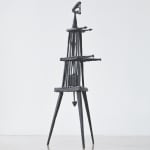Geoffrey Clarke British, 1924-2014
Figure, 1952
Welded iron
151 x 56 x 56 cm
59 1/2 x 22 1/8 x 22 1/8 in
59 1/2 x 22 1/8 x 22 1/8 in
Unique
Further images
In 1952, the same year Geoffrey Clarke he was selected as one of eight emerging sculptors to represent Great Britain at the Venice Biennale. Alongside his contemporaries Reg Butler and...
In 1952, the same year Geoffrey Clarke he was selected as one of eight emerging sculptors to represent Great Britain at the Venice Biennale. Alongside his contemporaries Reg Butler and Lynn Chadwick, Clarke’s work was described in 1952 by the influential art critic Herbert Read as evoking the ‘geometry of fear’. In this way Clarke’s early works, such as ‘Figure’, were to be characterised by their battered or tortured appearance. With its innovative use of iron as material ‘Figure’ radically reframed what figurative sculpture could be in what Read termed ‘Britain’s New Iron Age’ (1953).
In the early to mid-1950s Clarke used iron, stained glass, enamel and printmaking techniques to create linear images of Man. Clarke then began making a number of important discoveries casting in aluminium. In the 1950s he successfully experimented with making models of his sculptures in the then-relatively new material of polystyrene, and direct casting in aluminium. This process was relatively inexpensive in comparison to casting in bronze, and produced sculptures of lighter weight. Public commissions came thick and fast. Clarke’s dual success in both stained glass and sculpture was marked by a series of significant exhibitions and commissions in the 1950s and 60s.
In 1965, he had a major retrospective at the Redfern Gallery, London and his work was included in British Sculpture in the 1960s exhibition at the Tate Gallery. He was selected for British Sculptors ‘72 curated by Bryan Kneale at the Royal Academy of Arts and for British Sculpture in the Twentieth Century at the Whitechapel Art Gallery in 1981. His work is held in many prestigious public and private collections around the world.
In 2017, to co-inside with a major retrospective held at the gallery, Pangolin London published the artist’s highly anticipated Catalogue Raisonné written by Clarke's biographer, Dr Judith LeGrove.
Pangolin London represents the estate of Geoffrey Clarke.
In the early to mid-1950s Clarke used iron, stained glass, enamel and printmaking techniques to create linear images of Man. Clarke then began making a number of important discoveries casting in aluminium. In the 1950s he successfully experimented with making models of his sculptures in the then-relatively new material of polystyrene, and direct casting in aluminium. This process was relatively inexpensive in comparison to casting in bronze, and produced sculptures of lighter weight. Public commissions came thick and fast. Clarke’s dual success in both stained glass and sculpture was marked by a series of significant exhibitions and commissions in the 1950s and 60s.
In 1965, he had a major retrospective at the Redfern Gallery, London and his work was included in British Sculpture in the 1960s exhibition at the Tate Gallery. He was selected for British Sculptors ‘72 curated by Bryan Kneale at the Royal Academy of Arts and for British Sculpture in the Twentieth Century at the Whitechapel Art Gallery in 1981. His work is held in many prestigious public and private collections around the world.
In 2017, to co-inside with a major retrospective held at the gallery, Pangolin London published the artist’s highly anticipated Catalogue Raisonné written by Clarke's biographer, Dr Judith LeGrove.
Pangolin London represents the estate of Geoffrey Clarke.
Provenance
From the artist's estate.
Exhibitions
Geoffrey Clarke: A Retrospective, 2017; Masterpiece London 2017
Towards a New World: Sculpture in Post-War Britain, Marlborough Gallery, London March 16 - April 22, 2023
Literature
Geoffrey Clarke Sculptor: Catalogue Raisonne By Dr Judith Le Grove, 2017, pg.33
Publications
Geoffrey Clarke Sculptor: Catalogue Raisonne By Dr Judith Le Grove, 2017, pg.33
Join our mailing list
* denotes required fields
We will process the personal data you have supplied in accordance with our privacy policy (available on request). You can unsubscribe or change your preferences at any time by clicking the link in our emails.







